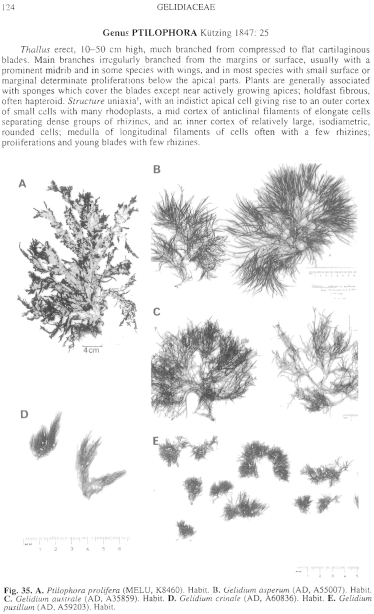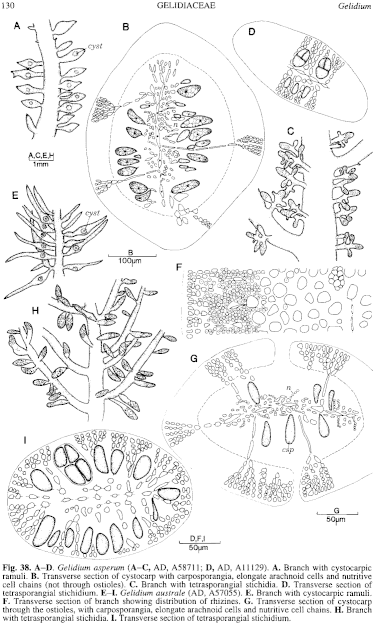|
|
|
|
|
|||||||||||
|
Electronic Flora of South Australia Species Fact Sheet
Phylum Rhodophyta – Class Florideophyceae – Order Gelidiales – Family Gelidiaceae
Selected citations: Agardh 1852: 475; 1876: 551. Kützing 1849: 764. Sonder 1853: 685.
Synonyms
Sphaerococcus asper C. Agardh 1822: 288; 1824: 228.
Gelidium glandulaefolium Hooker & Harvey 1847: 406. J. Agardh 1852: 474; 1876: 551. Fuhrer et al. 1981, pl. 53. Harvey 1858: pl. 18; 1859b: 315. Kützing 1849: 766; 1868: 16, pl. 45a-c. Sonder 1853: 685; 1855: 520.
Thallus (Fig. 35B) dark red-brown, cartilaginous, forming erect, usually densely branched tufts 10–30 (–40) cm high, with one to several irregularly branched axes. Axes tapering only slightly from base to upper parts, slightly compressed, 1–2 (–3) mm across (B/T 1.5–2) below and often thickened, 750–1250 µm across in mid parts, (200–) 400–600 µm across near apices; branching usually fastigiate, sometimes spreading, of 2–3 orders, laterals subterete to slightly compressed, 0.5–2 (–7) cm apart, often more or less subdistichous, alternate to subopposite, linear and slightly contracted basally and terminally, usually with simple ends several cm long, occasionally with clumped proliferous branches. Holdfast 0.5–2 cm across, of slender haptera and with short stolons; epilithic. Structure. Cortex 3–5 cells thick, outer cortical cells more or less in surface longitudinal rows, with the protoplast 3–5 µm across in surface view, walls thin, inner cells becoming radially elongate; medulla of longitudinally elongate cells, with few hyphae except in older axes; rhizines scattered through medulla in younger branches, also dense in inner cortex in older parts.
Reproduction: Fertile ramuli scattered, borne all around the branches or often tending to two sides. Cystocarps (Fig. 38A, B) in ramuli 600–1200 µm long, one (rarely two) per ramulus forming a central swelling 150–250 µm across, bilocular with a distinct ostiole (occasionally slightly raised) on each side; carposporangia elongate-ovoid to clavate, 20–30 µm in diameter; nutritive cell chains and elongate arachnoid filaments present. Spermatangial sori covering most of clavate to tapering ramuli 0.5–1.2 mm long and 250–350 µm in diameter, with the outer cortical cells replaced by elongate spermatangial initials from which subspherical to ovoid spermatangia 1–1.5 µm in diameter are cut off terminally.
Stichidia (Fig. 38C) short-stalked, terete to compressed, more or less clavate, 500–1000 (–1500) µm long and 120–250 µm broad, with only slight medulla, usually on small branch systems. Tetrasporangia (Fig. 38D) ovoid, 20–30 µm in diameter, lying in the inner cortex, decussately cruciately divided.
Type from "Cape van Diemen", S Tas. (Labillardière); in Herb. Agardh, LD, lectotype 33216.
Selected specimens: Lands End, West I., S. Aust., 16–20 m deep (Shepherd, 2.i.1967; AD, A31612). Port Elliot, S. Aust., drift (Womersley, 24.vii.1949; AD, A11129). Cape Lannes, S. Aust., 3–4 m deep (Kraft, 14.v.1972; AD, A58711). Cape Northumberland, S. Aust., 2–3 m deep (Edyvane, 5.vi.I 982; AD, A55007). Lady Julia Percy 1., Vic., 20 m deep (Shepherd, 4.i.1968; AD, A32428). Point Roadknight, Vic., drift (Sinkora A1424, 29.xi.1971; AD, A43143). Cat Bay, Phillip I., Vic., drift (Womersley, 10.iv.1959; AD, A22723). Walkerville, Vic., drift (Sinkora A1599, 23.ii.1972; AD, A43250). Deal I., Bass Str., 5 m deep (Shepherd & Lewis, 3.v.1974; AD, A45220). Fluted Cape, Bruny I., Tas., 7–10 m deep (Shepherd, 10.ii.1972; AD, A41455).
Distribution: West I., S. Aust., to Walkerville, Vic. and around Tasmania.
Taxonomic notes: G. asperum is a subtidal species, known from 3–20 m deep and in shaded deep pools. It is the most robust of the terete or slightly compressed branched species, distinguished by the often distant branching (especially near the apices) and the fringing fertile ramuli which frequently tend to be on two sides of the branches; the fertile ramuli are usually simple, but in some tetrasporangial plants they develop into short, branched systems.
Type material in LD includes the lectotype labelled "Fucus asper M, d. Labillardière" and a second syntype specimen labelled "Gelidium ciliatulum Lamour. herb. Labill. e Cap. v. Diemen dedit Labill." Both are similar and probably from the same collection. They are depauperate specimens, with bases only of fertile ramuli, but are recognisable as the later-described G. glandulaefolium [type from Circular Head, N Tas. (Smith); in BM, ex K]. There is also a specimen in MEL (547621) from "a litt. Nova Hollandia" named "Fucus asper" by Mertens, but in view of the different locality this is probably not type material.
The record by Kützing (1868, p. 15, pl. 43a,b) from South Africa of G. asperum clearly applies to a different species.
References:
AGARDH, C.A. (1822). Species Algarum. Vol. 1, Part 2, pp. 169–398. (Berling: Lund.)
AGARDH, C.A. (1824). Systema Algarum. (Berling: Lund.)
AGARDH, J.G. (1852). Species Genera et Ordines Algarum. Vol. 2, Part 2, pp. 337–720. (Gleerup: Lund.)
AGARDH, J.G. (1876). Species Genera et Ordines Algarum. Vol. 3, Part 1 - Epicrisis systematis Floridearum, pp. i-vii, 1–724. (Weigel: Leipzig.)
FUHRER, B., CHRISTIANSON, I.G., CLAYTON, M.N. & ALLENDER, B.M. (1981). Seaweeds of Australia. (Reed: Sydney.)
GREVILLE, R.K. (1830). Algae Britannicae. (Maclachlan & Stewart: Edinburgh.)
HARVEY, W.H. (1858). Phycologia Australica. Vol. 1, Plates 1–60. (Reeve: London.)
HARVEY, W.H. (1859b). Algae. In Hooker, J.D., The Botany of the Antarctic Voyage. Flora Tasmaniae. Vol. II, pp. 282–320.
HOOKER, J.D. & HARVEY, W.H. (1847). Algae Tasmanicae. Lond. J. Bot. 6, 397–417.
KÜTZING, F.T. (1849). Species Algarum. (Leipzig.)
KÜTZING, F.T. (1868). Tabulae Phycologicae. Vol. 18. (Nordhausen.)
SONDER, O.W. (1853). Plantae Muellerianae. Algae. Linnaea 25, 657–709.
SONDER, O.W. (1855). Algae annis 1852 et 1853 collectae. Linnaea 26, 506–528.
The Marine Benthic Flora of Southern Australia Part IIIA complete list of references.
Publication:
Womersley, H.B.S. (14 January, 1994)
The Marine Benthic Flora of Southern Australia
Rhodophyta. Part IIIA, Bangiophyceae and Florideophyceae (to Gigartinales)
Reproduced with permission from The Marine Benthic Flora of Southern Australia Part IIIA 1994, by H.B.S. Womersley. Australian Biological Resources Study, Canberra. Copyright Commonwealth of Australia.
Illustrations in Womersley Part IIIA, 1994: FIGS 35B, 38 A–D.

Figure 35 enlarge
Fig. 35. A. Ptilophora prolifera (MELU, K8460). Habit. B. Gelidium asperum (AD, A55007). Habit. C. Gelidium australe (AD, A35859). Habit. D. Gelidium crinale (AD, A60836). Habit. E. Gelidium pusillum (AD, A59203). Habit.

Figure 38 enlarge
Fig. 38. A–D. Gelidium asperum (A–C, AD, A58711; D, AD, A11129). A. Branch with cystocarpic ramuli. B. Transverse section of cystocarp with carposporangia, elongate arachnoid cells and nutritive cell chains (not through ostioles). C. Branch with tetrasporangial stichidia. D. Transverse section of tetrasporangial stichidium. E–I. Gelidium australe (AD, A57055). E. Branch with cystocarpic ramuli. F. Transverse section of branch showing distribution of rhizines. G. Transverse section of cystocarp through the ostioles, with carposporangia, elongate arachnoid cells and nutritive cell chains. H. Branch with tetrasporangial stichidia. I. Transverse section of tetrasporangial stichidium.

|
Email Contact: State Herbarium of South Australia |

|